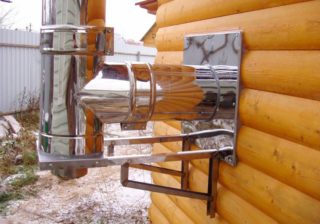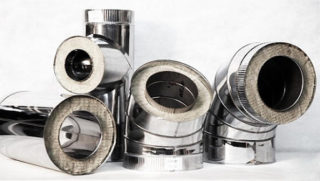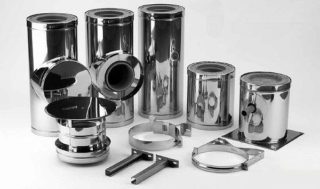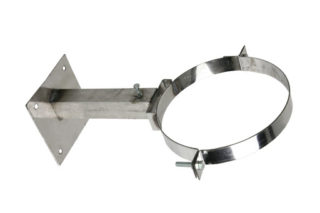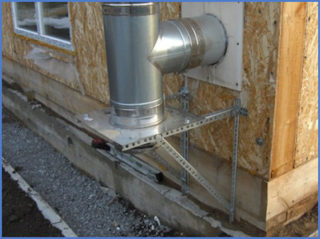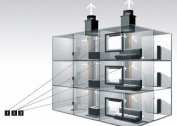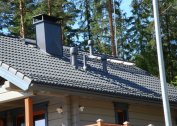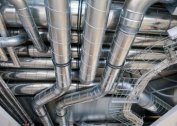In order to equip housing with a stove, a solid-fuel type plant or an atmospheric gas boiler, it is necessary to organize a channel for the removal of combustion products. You can lay it out of brick, but this is a big financial and labor cost, in some cases it is impossible to implement the project due to the design features of the house. In the presence of such difficulties, the chimney is mounted to the wall. The option also wins because you can do the work yourself, without involving a professional team of installers.
What is a chimney flue sandwich
The element got its name due to the puff structure. There is a filling that is placed between two bases. Insulation acts as the first, in the role of bases - metal pipes of different diameters. The entire system is a complete installation unit. By combining a certain number of such elements, chimneys of different heights are obtained. These are basic parts, we also need fasteners for the chimney, various branches and additional devices.
Construction materials
The three-layer construction, which is the basis of a single pipe element, consists of the following materials:
- The inner working casing for the removal of combustion products. More often made of stainless steel AISI 316.
- Filler designed for insulation.
- External casing or bearing AISI 304 brand, which serves as a frame. It is fixed to the wall.
A feature of the internal chimney is the ability to withstand gases, the temperature of which reaches 900 degrees Celsius. The outer shell has good resistance to aggressive environments.
Connection types
Sandwich elements are interconnected by the type of elbows - on one side of the socket there is a cylindrical docking groove without insulation, where the end of the other chimney is inserted to the persistent skirt. This is convenient and allows only tightening clamps to be used for tightly locking the cylinders together.
The fastening of the chimney to the wall plane occurs due to supporting clamps of various diameters and lengths of holders. Sometimes instead of them there is one rack, which at the end has the shape of a screw. This part is simply screwed into a plastic dowel inserted into concrete.
Type of insulation and wall thickness
Basalt-based cotton wool is used as a heater between the inner and outer casing in this type of construction. This is the only possible thermal insulation option, since mineral wool is not a combustible material, therefore it can withstand high temperatures with ease. The thickness of the basalt layer itself depends primarily on the diameter of the pipe. On average, this size ranges from 60 to 40 mm, and the density is 125 kilograms per cubic meter.
If we take the wall thickness of the stainless steel metal, then the standard is 1-0.5 mm for the inner casing, 0.4 mm for the external, not subject to strong heat.
Advantages and disadvantages
The gas exhaust channel, organized on the basis of a sandwich smoke, has the following positive aspects:
- High-quality insulation, minimizing the negative factors of condensate on the inner walls and icing of the channel.
- Due to the smoothness of the walls, soot practically does not settle on them and is easily cleaned.
- The pipes are heat-resistant, have a long service life before burning.
- The frame itself can be assembled quickly and it will be cheaper than laying out a brick massif.
- Maintenance is easy, as you can detach a section anywhere and revise a channel.
The sandwich elements have one significant drawback - during prolonged use, there may be a deterioration in the sealing of joints between the individual components.
If you compare the price of a metal frame with the price of brickwork, the latter will cost more, but the sandwich's multilayer structure cannot be called cheap.
Chimney device made of sandwich elements
A double-walled duct smoker can contain these standard elements:
- Sandwiches of various lengths. This is the main material that the frame of the structure consists of.
- Double-walled chimney starting. It is designed to connect the output of the boiler or furnace with the other components of the system.
- Double-walled tee with insulation. Performs the function of transition from horizontal output to a vertical section.
- Condensate collector face. It is installed in the lower part of the tee to remove moisture flowing down the walls of the smoke chamber.
- Support bracket for the chimney - holds the entire mass of the structure.
- Retraction - this part allows you to shift the direction of the vertical, if necessary, bypass the overhang of the roof or other obstacle.
- Clamps for fixing. They compress the joints of the sandwich elements.
- Cap. It is put on top to protect the channel from getting inside precipitation.
- Wall bracket.
All items listed should be the same diameter.
If the distance of the channel from the last point of its fastening to the wall to the top exceeds 1.5 meters, a special clamp for stretch marks should be installed on this segment. A structure not reinforced with cables can easily fall off during heavy winds.
Bracket Design Features
The most common type of fastener is an adjustable bracket for fixing the flue to the wall. It consists of two rods with round holes for screwing to the house and oblong grooves for the possibility of changing the position of the clamp relative to the outside of the wall.
The clamp itself consists of two parts: support and fixing. The first is fixed to the rods with screws, the second is attached to the support in the same way. The clamp is designed for a specific cylinder diameter.
Methods of fixing the chimney to the wall and the necessary tools
There are two common ways to install a chimney near the wall:
- Mast fastening involves the erection of a steel structure from corners and profile fittings. This support should have an internal section larger than the outer diameter of the cylinder, since the latter is placed in the middle. The lower part of the mast is concreted into the ground, the upper part is fastened with four extensions.
- Fixing to the wall at a distance involves the use of support brackets, which are directly screwed to the supporting structure, and the smoker is already fixed to them.
In the first case, it is necessary to have as tools: a welding machine, a device for cutting metal, a set of wrenches and other devices. In the version with brackets - an electric hammer drill.
How to fix a chimney pipe to the wall with your own hands
To build a chimney from sandwich elements yourself, you must:
- Drill a hole in the wall under the side outlet of the flue.
- Recapture the vertical and mark the points for mounting the fasteners at least one meter later.
- Drill holes according to the marking and install in each bracket for the chimney.
- Assemble the flue from the bottom up, gradually fixing each section in the clamp.
The position of the channel should be strictly vertical.
Perform these complex installation work in a safe manner.Be sure to have insurance of stairs and supports while staying at height.
